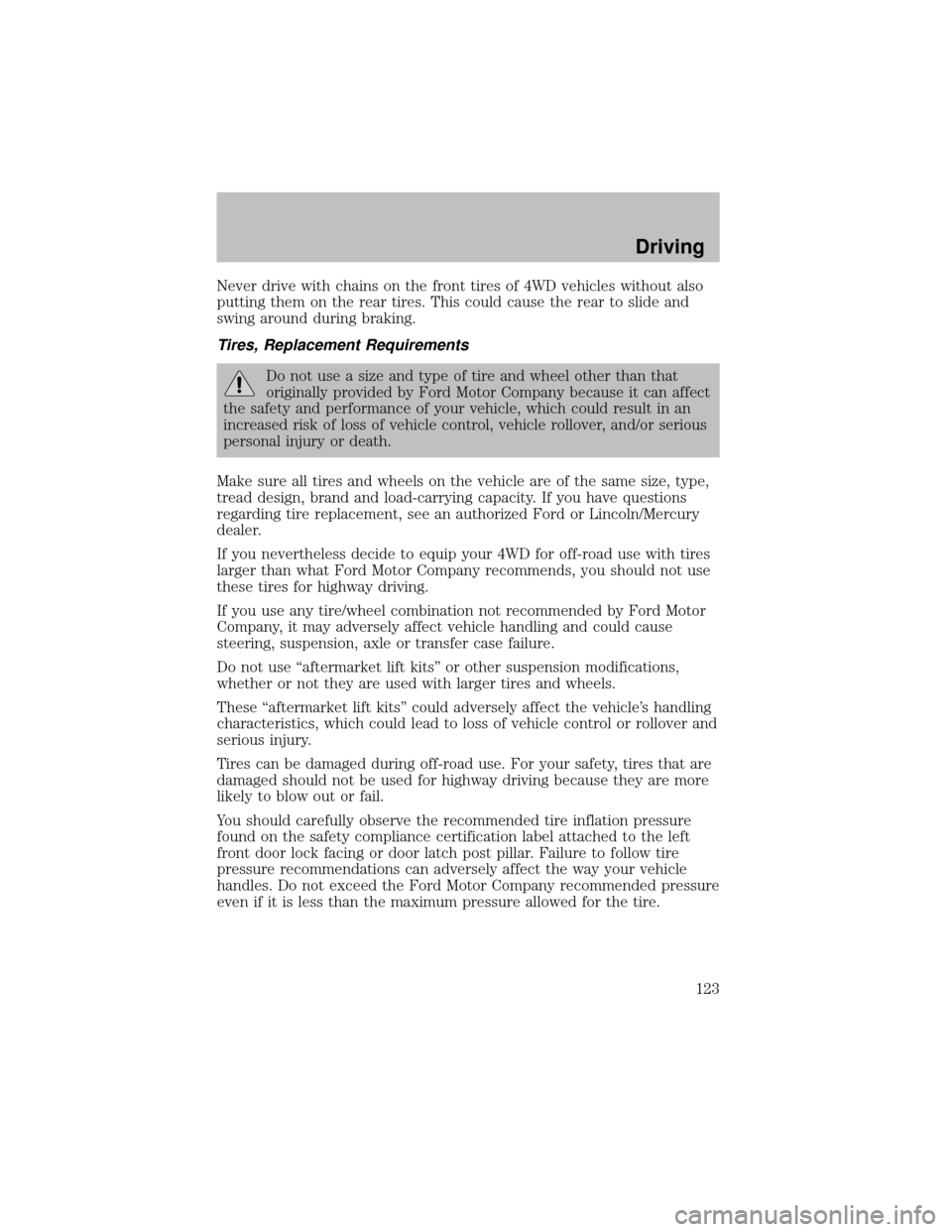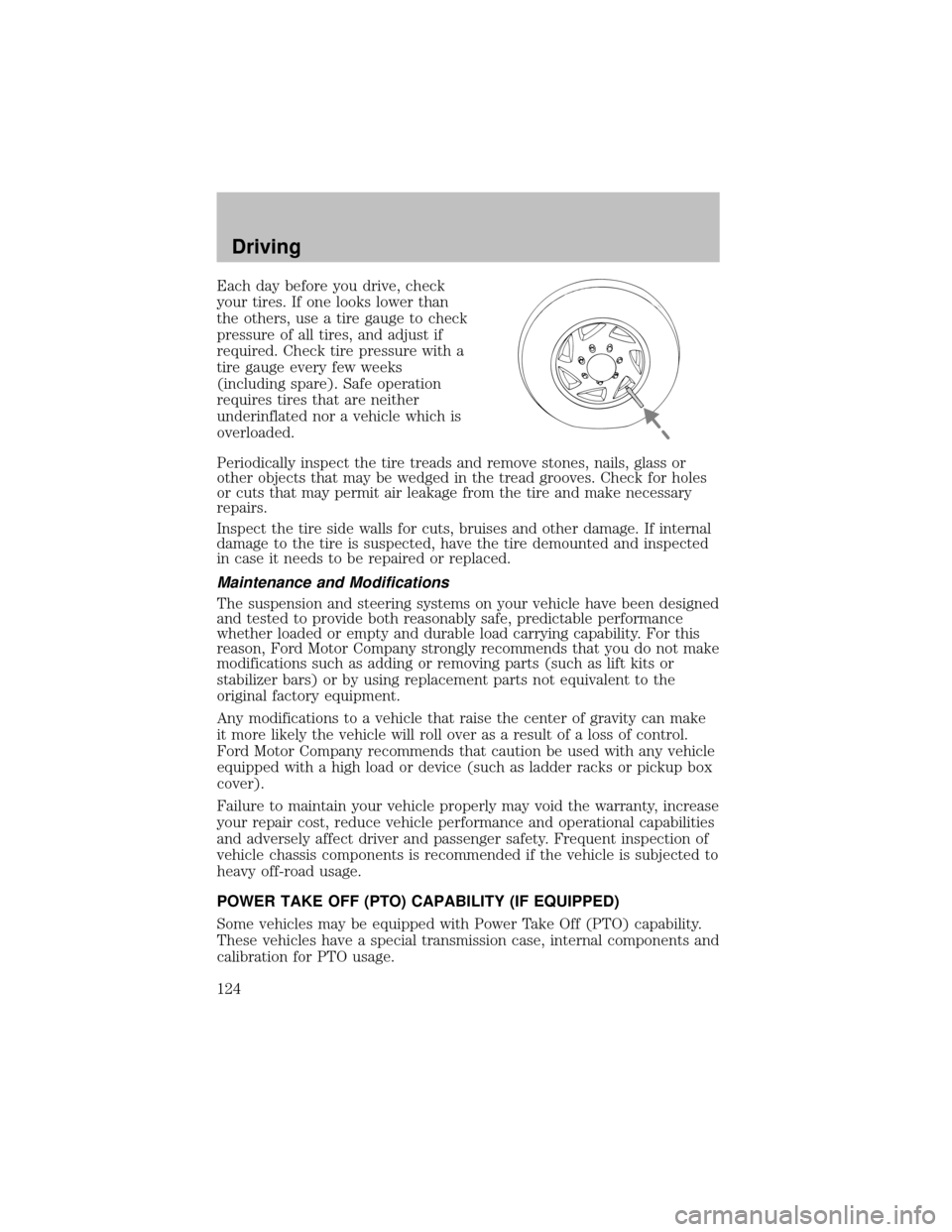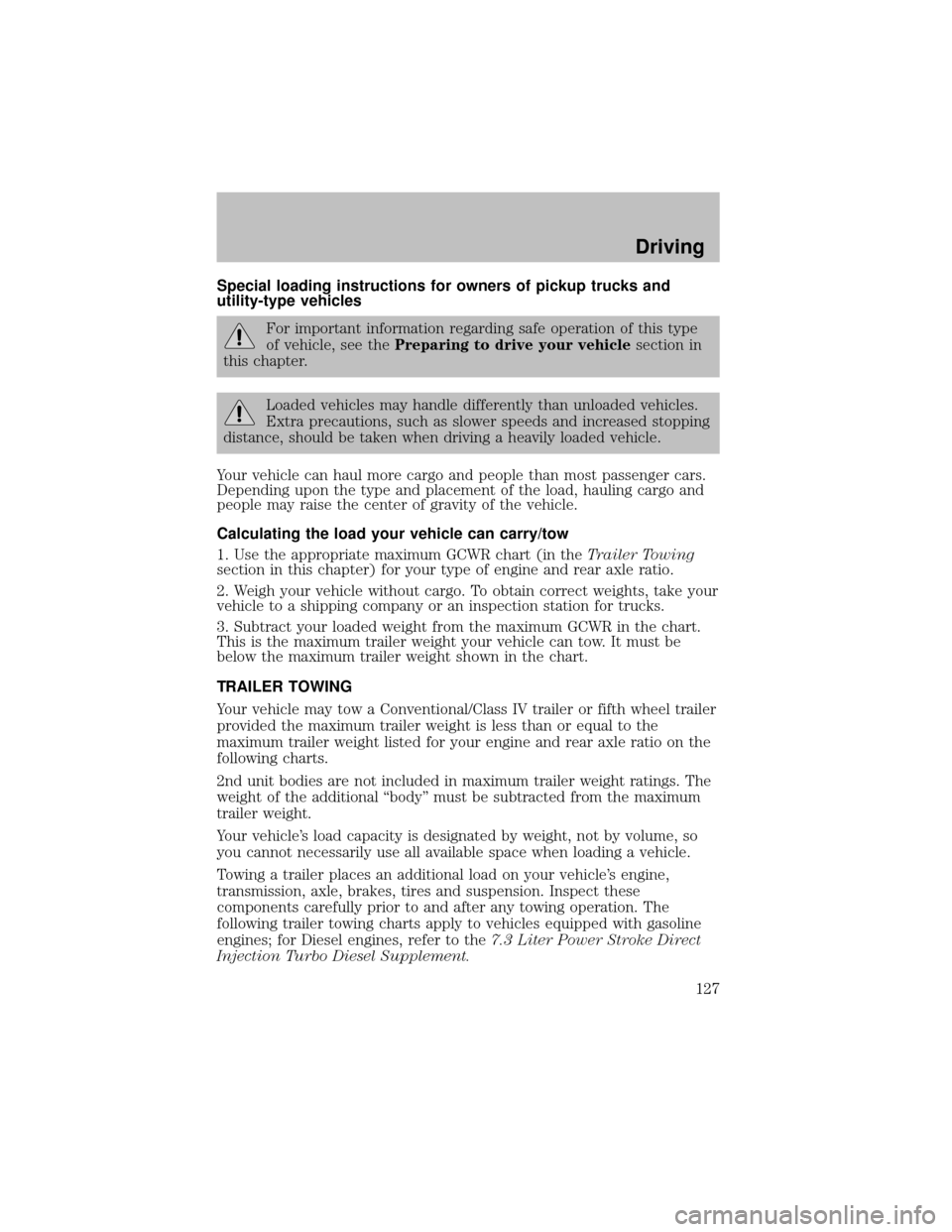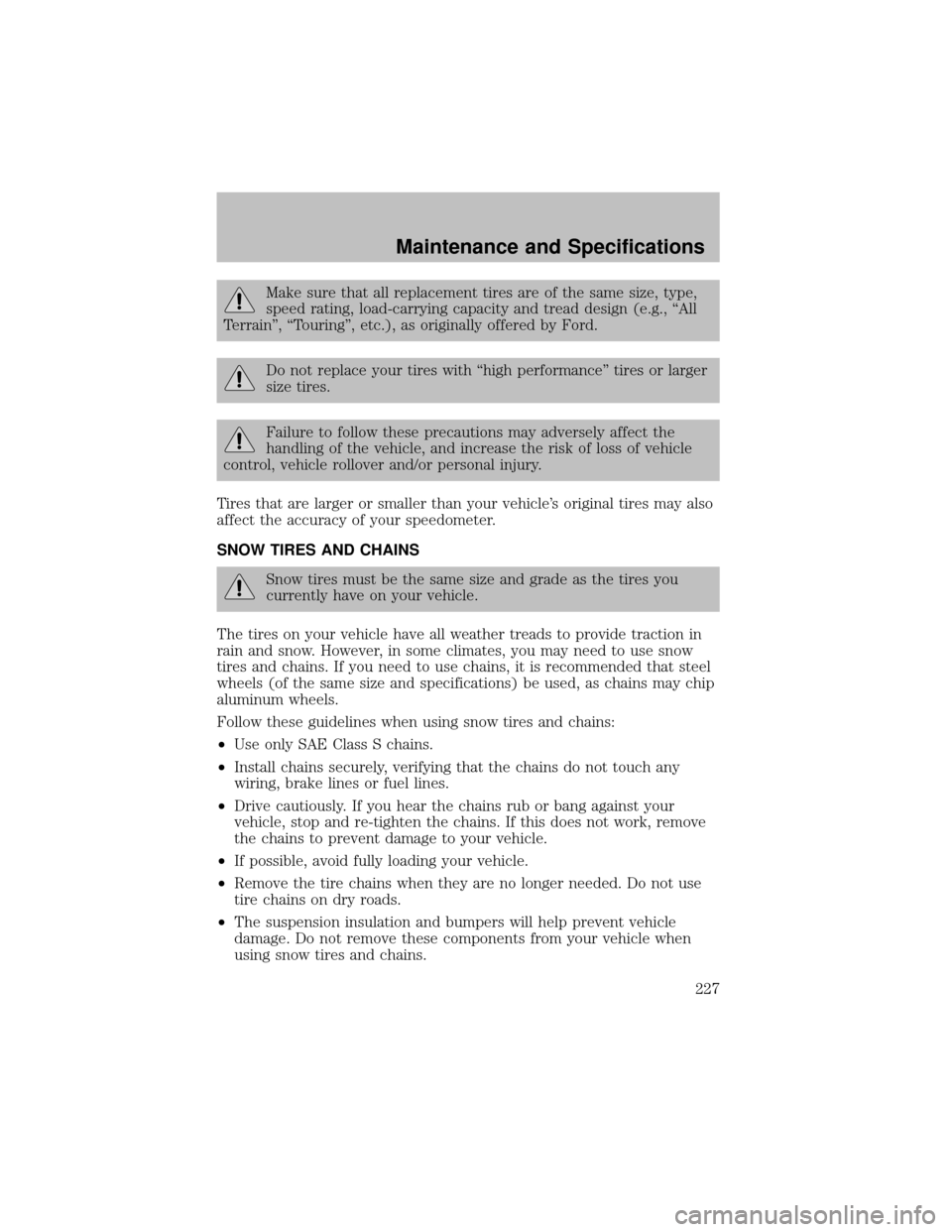2003 FORD SUPER DUTY suspension
[x] Cancel search: suspensionPage 12 of 256

Check air suspension
(if equipped):Illuminates when
the air suspension switch is turned
OFF, the load limit is exceeded or
the air suspension requires servicing.
Low fuel:Illuminates when the fuel
level in the fuel tank is at, or near
empty(refer toFuel gaugein this
chapter).
Speed control:Illuminates when
the speed control is activated. Turns
off when the speed control system
is deactivated.
Transmission Tow/Haul Feature
(if equipped):The ON light on the
end of the gearshift lever illuminates
when the Tow/Haul feature has been
selected. Refer to theDriving
chapter for transmission function and operation. If the light flashes
steadily, have the sy stem serviced immediately, damage to the
transmission could occur.
Transmission control indicator
light (TCIL) (if equipped):
Illuminates when the overdrive
function of the transmission has
been turned off, refer to the
Drivingchapter. If the light flashes steadily, have the sy stem serviced
immediately, damage to the transmission could occur.
Four wheel drive low
(if equipped):Illuminates when
four-wheel drive low is engaged.
Four wheel drive indicator
(if equipped):Illuminates when
four-wheel drive is engaged.CHECK
SUSP
OVERDRIVE
LOW
RANGE
4x4
Instrument Cluster
12
Page 105 of 256

hold the brake pedal down, release the parking brake, then trypushing
the parking brake pedal further down. Chock the wheels if required. If
the parking brake cannot hold the weight of the vehicle, the parking
brake mayneed to be serviced.
STEERING
To prevent damage to the power steering system:
•Never hold the steering wheel at its furthest turning points (until it
stops) for more than a few seconds when the engine is running.
•Do not operate the vehicle with a low power steering pump fluid level
(below the MIN mark on the reservoir).
If the power steering system breaks down (or if the engine is turned
off), you can steer the vehicle manually, but it takes more effort.
If the steering wanders or pulls, check for:
•an underinflated tire
•uneven tire wear
•loose or worn suspension components
•loose or worn steering components
•improper steering alignment
TRACTION-LOK AXLE (IF EQUIPPED)
This axle provides added traction on slipperysurfaces, particularlywhen
one wheel is on a poor traction surface. Under normal conditions, the
Traction-Lok axle functions like a standard rear axle.
To reduce the risk of injury, never run the engine with one wheel
off the ground, such as when changing a tire.
PREPARING TO DRIVE YOUR VEHICLE
Utilityvehicles have a significantlyhigher rollover rate than
other types of vehicles.
In a rollover crash, an unbelted person is significantlymore likely
to die than a person wearing a safetybelt.
Your vehicle has larger tires and increased ground clearance, giving the
vehicle a higher center of gravitythan a passenger car.
Driving
105
Page 123 of 256

Never drive with chains on the front tires of 4WD vehicles without also
putting them on the rear tires. This could cause the rear to slide and
swing around during braking.
Tires, Replacement Requirements
Do not use a size and type of tire and wheel other than that
originallyprovided byFord Motor Companybecause it can affect
the safetyand performance of your vehicle, which could result in an
increased risk of loss of vehicle control, vehicle rollover, and/or serious
personal injuryor death.
Make sure all tires and wheels on the vehicle are of the same size, type,
tread design, brand and load-carrying capacity. If you have questions
regarding tire replacement, see an authorized Ford or Lincoln/Mercury
dealer.
If you nevertheless decide to equip your 4WD for off-road use with tires
larger than what Ford Motor Companyrecommends, you should not use
these tires for highwaydriving.
If you use anytire/wheel combination not recommended byFord Motor
Company, it may adversely affect vehicle handling and could cause
steering, suspension, axle or transfer case failure.
Do not use “aftermarket lift kits” or other suspension modifications,
whether or not theyare used with larger tires and wheels.
These “aftermarket lift kits” could adverselyaffect the vehicle’s handling
characteristics, which could lead to loss of vehicle control or rollover and
serious injury.
Tires can be damaged during off-road use. For your safety, tires that are
damaged should not be used for highwaydriving because theyare more
likelyto blow out or fail.
You should carefullyobserve the recommended tire inflation pressure
found on the safetycompliance certification label attached to the left
front door lock facing or door latch post pillar. Failure to follow tire
pressure recommendations can adverselyaffect the wayyour vehicle
handles. Do not exceed the Ford Motor Companyrecommended pressure
even if it is less than the maximum pressure allowed for the tire.
Driving
123
Page 124 of 256

Each daybefore you drive, check
your tires. If one looks lower than
the others, use a tire gauge to check
pressure of all tires, and adjust if
required. Check tire pressure with a
tire gauge everyfew weeks
(including spare). Safe operation
requires tires that are neither
underinflated nor a vehicle which is
overloaded.
Periodicallyinspect the tire treads and remove stones, nails, glass or
other objects that maybe wedged in the tread grooves. Check for holes
or cuts that maypermit air leakage from the tire and make necessary
repairs.
Inspect the tire side walls for cuts, bruises and other damage. If internal
damage to the tire is suspected, have the tire demounted and inspected
in case it needs to be repaired or replaced.
Maintenance and Modifications
The suspension and steering systems on your vehicle have been designed
and tested to provide both reasonablysafe, predictable performance
whether loaded or emptyand durable load carrying capability. For this
reason, Ford Motor Companystronglyrecommends that you do not make
modifications such as adding or removing parts (such as lift kits or
stabilizer bars) or byusing replacement parts not equivalent to the
original factoryequipment.
Anymodifications to a vehicle that raise the center of gravitycan make
it more likelythe vehicle will roll over as a result of a loss of control.
Ford Motor Companyrecommends that caution be used with anyvehicle
equipped with a high load or device (such as ladder racks or pickup box
cover).
Failure to maintain your vehicle properlymayvoid the warranty, increase
your repair cost, reduce vehicle performance and operational capabilities
and adverselyaffect driver and passenger safety. Frequent inspection of
vehicle chassis components is recommended if the vehicle is subjected to
heavyoff-road usage.
POWER TAKE OFF (PTO) CAPABILITY (IF EQUIPPED)
Some vehicles maybe equipped with Power Take Off (PTO) capability.
These vehicles have a special transmission case, internal components and
calibration for PTO usage.
Driving
124
Page 127 of 256

Special loading instructions for owners of pickup trucks and
utility-type vehicles
For important information regarding safe operation of this type
of vehicle, see thePreparing to drive your vehiclesection in
this chapter.
Loaded vehicles mayhandle differentlythan unloaded vehicles.
Extra precautions, such as slower speeds and increased stopping
distance, should be taken when driving a heavilyloaded vehicle.
Your vehicle can haul more cargo and people than most passenger cars.
Depending upon the type and placement of the load, hauling cargo and
people mayraise the center of gravityof the vehicle.
Calculating the load your vehicle can carry/tow
1. Use the appropriate maximum GCWR chart (in theTrailer Towing
section in this chapter) for your type of engine and rear axle ratio.
2. Weigh your vehicle without cargo. To obtain correct weights, take your
vehicle to a shipping companyor an inspection station for trucks.
3. Subtract your loaded weight from the maximum GCWR in the chart.
This is the maximum trailer weight your vehicle can tow. It must be
below the maximum trailer weight shown in the chart.
TRAILER TOWING
Your vehicle maytow a Conventional/Class IV trailer or fifth wheel trailer
provided the maximum trailer weight is less than or equal to the
maximum trailer weight listed for your engine and rear axle ratio on the
following charts.
2nd unit bodies are not included in maximum trailer weight ratings. The
weight of the additional “body” must be subtracted from the maximum
trailer weight.
Your vehicle’s load capacityis designated byweight, not byvolume, so
you cannot necessarily use all available space when loading a vehicle.
Towing a trailer places an additional load on your vehicle’s engine,
transmission, axle, brakes, tires and suspension. Inspect these
components carefullyprior to and after anytowing operation. The
following trailer towing charts applyto vehicles equipped with gasoline
engines; for Diesel engines, refer to the7.3 Liter Power Stroke Direct
Injection Turbo Diesel Supplement.
Driving
127
Page 227 of 256

Make sure that all replacement tires are of the same size, type,
speed rating, load-carrying capacity and tread design (e.g., “All
Terrain”, “Touring”, etc.), as originallyoffered byFord.
Do not replace your tires with “high performance” tires or larger
size tires.
Failure to follow these precautions mayadverselyaffect the
handling of the vehicle, and increase the risk of loss of vehicle
control, vehicle rollover and/or personal injury.
Tires that are larger or smaller than your vehicle’s original tires may also
affect the accuracyof your speedometer.
SNOW TIRES AND CHAINS
Snow tires must be the same size and grade as the tires you
currentlyhave on your vehicle.
The tires on your vehicle have all weather treads to provide traction in
rain and snow. However, in some climates, you may need to use snow
tires and chains. If you need to use chains, it is recommended that steel
wheels (of the same size and specifications) be used, as chains maychip
aluminum wheels.
Follow these guidelines when using snow tires and chains:
•Use onlySAE Class S chains.
•Install chains securely, verify ing that the chains do not touch any
wiring, brake lines or fuel lines.
•Drive cautiously. If you hear the chains rub or bang against your
vehicle, stop and re-tighten the chains. If this does not work, remove
the chains to prevent damage to your vehicle.
•If possible, avoid fullyloading your vehicle.
•Remove the tire chains when theyare no longer needed. Do not use
tire chains on dryroads.
•The suspension insulation and bumpers will help prevent vehicle
damage. Do not remove these components from your vehicle when
using snow tires and chains.
Maintenance and Specifications
227